
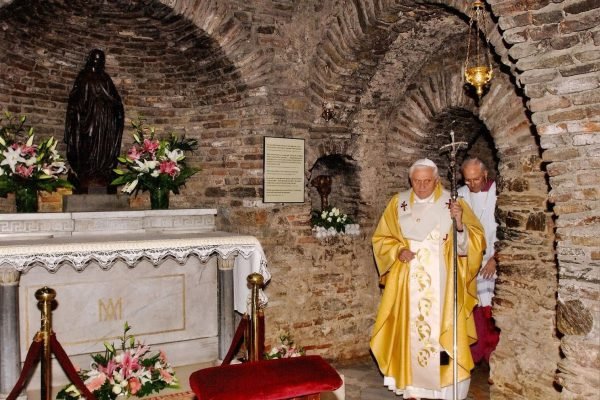





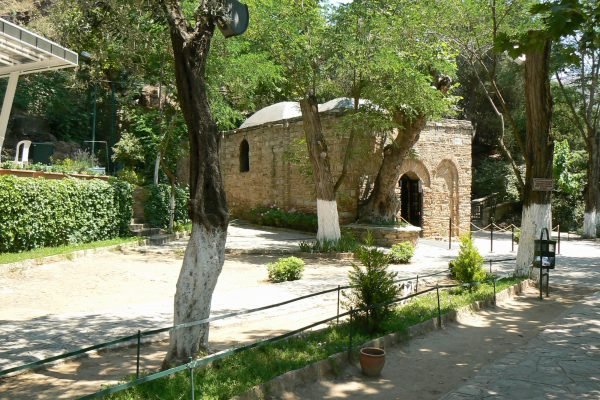
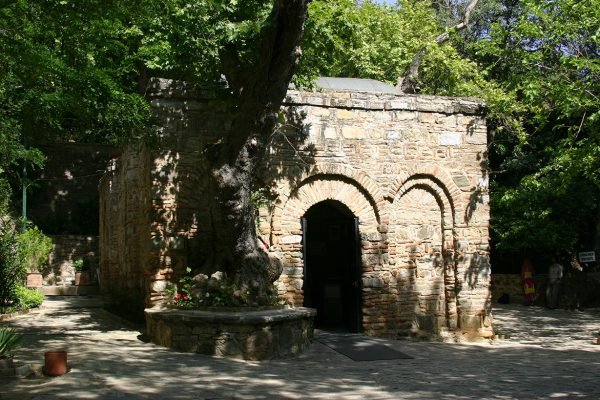
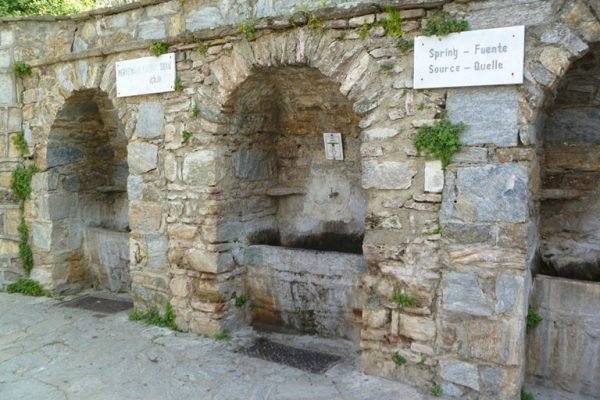
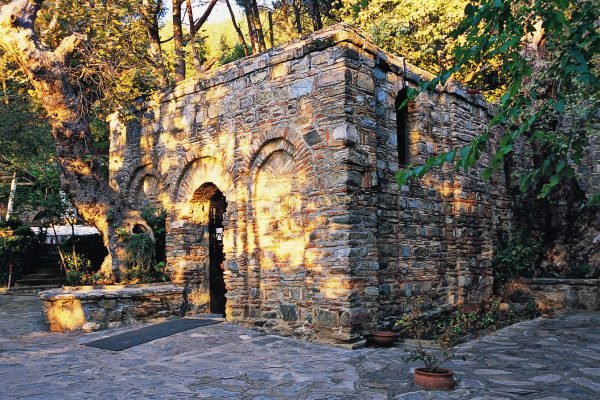
About House of Virgin Mary (Meryem Ana Evi)
The House of Virgin Mary (Turkish: Meryem Ana Evi) is a sacred pilgrimage site on the slopes of Mount Koressos, about 7 kilometers from Ephesus in Izmir, Turkey. Surrounded by pine and olive trees, it has welcomed visitors for more than a century and remains one of the most meaningful spiritual destinations in the country.
History and Discovery
According to Christian tradition, this is the place where the Virgin Mary spent her final years under the care of St. John the Apostle. The modest chapel that stands today was built of stone in a cruciform plan with a domed roof. Archaeological studies suggest the foundations date back to the 1st century AD, while the visible structure is from the 7th century.
The house was rediscovered in the 19th century following the visions of Blessed Anne Catherine Emmerich, a German nun who described the location in detail. In 1951, the dwelling was restored, preserving its original stone masonry and modest interior.
A Place of Shared Devotion
The House of Virgin Mary is unique because it is venerated by both Christians and Muslims. For Christians, it is the home where Mary lived and died; for Muslims, it is respected as the dwelling of Meryem Ana, the mother of Prophet Jesus (Isa). A side prayer room is often used by Muslim visitors, symbolizing shared reverence.
In 1961, Pope John XXIII officially recognized the site as a Catholic pilgrimage destination. Since then, popes including Paul VI, John Paul II, and Benedict XVI have all prayed here, strengthening its global significance.
Pilgrimage Traditions
Pilgrims often light candles, drink from the holy spring water, and leave written prayers on the Wishing Wall. These traditions reflect hope, faith, and healing. Visitors frequently take bottles of spring water home, considering it blessed.
Surroundings and Attractions
The house lies close to major historical landmarks:
Ephesus Ancient City – UNESCO World Heritage Site with marble streets, the Library of Celsus, and the grand Theater.
Basilica of St. John – built in the 6th century, believed to be the burial place of the Apostle John.
Temple of Artemis – one of the Seven Wonders of the Ancient World.
Cave of the Seven Sleepers – important for both Christian and Islamic tradition.
Nearby, the town of Selcuk offers bazaars, museums, and traditional houses, while Kusadasi serves as a gateway for international cruise travelers.
Preservation and Cultural Impact
The stone structure has been carefully protected by Turkish authorities and the Catholic Church to maintain its authenticity. Restoration efforts preserved the ancient walls and arched doorways while keeping the interior simple. Documentaries and historical studies continue to highlight its cultural and spiritual value.
Why Visit the House of Virgin Mary?
Today, the site is more than an archaeological landmark—it is a living place of peace, prayer, and cultural meeting. Whether visitors come as pilgrims, history enthusiasts, or travelers exploring the Aegean, the House of Virgin Mary in Ephesus offers a rare blend of spirituality, history, and natural beauty.
House of Virgin Mary has been online since 2009, operated by Ephesus LLC (USA). For more than 15 years, our mission has been to keep alive the sacred memory of Ephesus and the Virgin Mary through prayers, wishes, and tours, offering visitors a place of faith, peace, and cultural connection. Beyond spirituality, our platform also provides shopping opportunities with authentic hand crafted items and a wide variety of unique products inspired by history and tradition, bringing this heritage closer to people worldwide.
House of the Virgin Mary: History, Faith, and Pilgrimage
Introduction
On the slopes of Mount Koressos near Ephesus lies a small stone chapel that has become one of the most remarkable sacred destinations in the world: the House of the Virgin Mary. Unlike many historical monuments that remain frozen in the past, this place continues to live through prayer, devotion, and interfaith reverence. Pilgrims from every continent, from diverse faith traditions, ascend the winding road to this quiet sanctuary, seeking peace, healing, and a sense of connection to the mother of Jesus.
What makes the House of the Virgin Mary extraordinary is not only its age or location, but the way it bridges centuries of tradition. Here, archaeology meets spirituality, local customs intertwine with global devotion, and history merges with personal faith. To understand the importance of this site, one must look at both the ancient Christian world and the modern pilgrim’s journey.
Mary in Early Christian Tradition
According to early Christian belief, the Apostle John took responsibility for Mary, the mother of Jesus, after the crucifixion. Tradition holds that John brought her to Ephesus, a major center of early Christianity, where she spent her final years. The humble stone dwelling on Mount Koressos reflects the modesty of her life, embodying the simplicity and faith associated with her story.
The location of the house also reflects the broader role of Ephesus in Christian history. The city hosted one of the earliest Christian communities and was the site of the Council of Ephesus in 431 AD, which affirmed Mary as Theotokos — “Mother of God.” This declaration not only shaped Christian theology but also elevated the status of Mary as a unifying figure across different Christian traditions.
Thus, the House of the Virgin Mary is not an isolated relic. It is embedded in the very foundations of Christian identity, linking the personal life of Mary to the universal development of the Church.
Visions of Catherine Emmerich and the Rediscovery
The modern recognition of the House of the Virgin Mary began not with archaeology but with faith. In the early 19th century, a German nun named Blessed Anne Catherine Emmerich experienced vivid visions of the life of the Virgin Mary. Though she never traveled outside her homeland, she described with striking detail a small stone dwelling on a wooded hillside near the ruins of Ephesus.
Her accounts, written down by the poet Clemens Brentano, were so precise that decades later explorers used them as a guide. In 1891, a team of Lazarist priests followed Emmerich’s descriptions and discovered the ruins of a stone house on Mount Koressos. The foundations dated to the early centuries of Christianity, and the chapel’s location matched her vision almost exactly.
For believers, this discovery was not a coincidence but a sign of divine providence. The visions of Emmerich provided spiritual confirmation of what archaeology later suggested. While historians may debate the details, the rediscovery marked the beginning of the site’s modern significance, transforming it from forgotten ruins into a destination of international pilgrimage.
The story of Emmerich illustrates the powerful intersection of faith and history. A visionary’s description, preserved through devotion, opened the way for countless pilgrims to reconnect with one of Christianity’s most beloved figures.
Interfaith Significance: Christianity and Islam
One of the most remarkable aspects of the House of the Virgin Mary is its ability to unite people of different faiths. For Christians, it is revered as the home where Mary spent her final years, the place where her earthly life came to an end. Pilgrims see the chapel as a continuation of the Gospel story, a site where devotion to the mother of Jesus is lived out in prayer and sacrament.
For Muslims, Mary — Meryem Ana — is equally honored. The Qur’an mentions her more times than the New Testament, presenting her as a model of purity, obedience, and faith. She is the only woman in Islamic tradition given an entire chapter in her name (Surah Maryam). Many Muslim visitors come to the shrine not out of curiosity, but with deep reverence, offering prayers in her honor and recognizing her as the mother of the Prophet Isa (Jesus).
This shared devotion makes the House of the Virgin Mary unique among pilgrimage sites. It is not only a Christian sanctuary but also a place where Muslims and Christians stand side by side in respect. In a world often divided by religion, this humble stone house offers a rare image of unity. The silence of the chapel, the glow of candles, and the prayers left at the Wishing Wall all testify that faith can transcend boundaries.
The interfaith character of the site continues to inspire dialogue and peacebuilding. Pilgrims leave not only with personal blessings but also with a renewed sense of common humanity.
Papal Visits and Global Recognition
The House of the Virgin Mary gained international prominence through the visits of several popes, each affirming its importance as a Catholic pilgrimage site. In 1967, Pope Paul VI became the first pope to visit the chapel, praying in silence within its modest stone walls. His pilgrimage sent a clear message that this site was not only locally venerated but also embraced by the universal Church.
In 1979, Pope John Paul II followed, celebrating Mass at the shrine during his visit to Turkey. His presence attracted worldwide attention and strengthened the role of the house as a symbol of faith and unity. John Paul II later beatified Anne Catherine Emmerich, linking her visions directly to the recognition of the shrine.
More recently, Pope Benedict XVI visited in 2006, further confirming the site’s global significance. Each papal visit has drawn new waves of pilgrims and inspired documentaries, academic studies, and media coverage, making the shrine a focal point not just of devotion but also of cultural dialogue.
Through these papal pilgrimages, the House of the Virgin Mary has become more than a local heritage site. It now stands as a symbol of shared Christian history, a bridge between East and West, and a testament to the enduring relevance of Marian devotion in the modern world.
Pilgrimage Practices in Modern Times
Every year, thousands of pilgrims and travelers arrive at the House of the Virgin Mary to take part in traditions that have been carried out for generations. These practices transform a simple historical visit into a living act of faith, creating an atmosphere that combines devotion with cultural heritage.
One of the most recognizable traditions is the act of lighting a candle. Pilgrims pause at the outdoor candle stands to dedicate a flame in prayer, whether for health, peace, gratitude, or the memory of loved ones. The sight of countless candles glowing together conveys a sense of unity and shared hope that transcends language and nationality.
Another cherished practice is leaving a prayer at the Wishing Wall. Visitors write personal petitions on small slips of paper and tie them to the stone wall, joining millions of prayers left over the decades. This collective expression of faith has made the Wishing Wall a powerful symbol of human longing and divine trust.
The holy springs near the chapel also play a central role. Tradition holds that each of the three taps represents blessings for health, wealth, and love. Pilgrims often collect the water in bottles to carry home as a sacred keepsake, seeing it as a tangible reminder of their journey.
Together, these practices reflect the unique blend of spirituality, tradition, and community that makes a pilgrimage to the House of the Virgin Mary a deeply moving experience.
Cultural Heritage and UNESCO Dimension
Beyond its religious significance, the House of the Virgin Mary is also a cultural treasure, preserved with great care by both Turkish authorities and the Catholic Church. The modest stone structure, with its arched doorway and domed roof, has undergone restorations that respect its ancient character while ensuring stability for future generations. Every effort has been made to maintain its simplicity, so that visitors experience the same sense of humility and peace that has defined the site for centuries.
The chapel and its surroundings are closely linked with the greater heritage of Ephesus, a UNESCO World Heritage Site. Pilgrims who travel here often combine their visit with the marble streets of Ephesus, the Library of Celsus, the Theater, and the Temple of Artemis, one of the Seven Wonders of the Ancient World. Together, these landmarks highlight the unique intersection of classical history and Christian spirituality.
International recognition has only strengthened the house’s importance. Documentaries, archaeological studies, and travel literature frequently feature the shrine, drawing attention not just to its spiritual role but also to its contribution to cultural dialogue. The blending of history, religion, and heritage makes the House of the Virgin Mary more than a sacred destination; it is a global symbol of shared memory and human devotion.
About HouseofVirginMary.com
Established in 2009, this independent cultural heritage website is dedicated to the history and
traditions surrounding the House of Virgin Mary in Ephesus, Türkiye.
It was created to share knowledge, inspire faith, and connect visitors from around the world with the
sacred legacy of Meryem Ana Evi.
Our website offers free spiritual experiences such as lighting a candle , posting a prayer on the Wishing Wall , and discovering the Holy Water tradition. Each reflects the timeless faith, hope, and unity shared by pilgrims through generations.
HouseofVirginMary.com is an independent cultural heritage guide site dedicated to sharing the story and spiritual traditions of the House of Virgin Mary in Ephesus, Türkiye.
Learn more about the historical background of the shrine at the official Wikipedia article on the House of the Virgin Mary .
